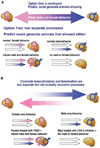Estradiol and the developing brain
- PMID: 18195084
- PMCID: PMC2754262
- DOI: 10.1152/physrev.00010.2007
Estradiol and the developing brain
Abstract
Estradiol is the most potent and ubiquitous member of a class of steroid hormones called estrogens. Fetuses and newborns are exposed to estradiol derived from their mother, their own gonads, and synthesized locally in their brains. Receptors for estradiol are nuclear transcription factors that regulate gene expression but also have actions at the membrane, including activation of signal transduction pathways. The developing brain expresses high levels of receptors for estradiol. The actions of estradiol on developing brain are generally permanent and range from establishment of sex differences to pervasive trophic and neuroprotective effects. Cellular end points mediated by estradiol include the following: 1) apoptosis, with estradiol preventing it in some regions but promoting it in others; 2) synaptogenesis, again estradiol promotes in some regions and inhibits in others; and 3) morphometry of neurons and astrocytes. Estradiol also impacts cellular physiology by modulating calcium handling, immediate-early-gene expression, and kinase activity. The specific mechanisms of estradiol action permanently impacting the brain are regionally specific and often involve neuronal/glial cross-talk. The introduction of endocrine disrupting compounds into the environment that mimic or alter the actions of estradiol has generated considerable concern, and the developing brain is a particularly sensitive target. Prostaglandins, glutamate, GABA, granulin, and focal adhesion kinase are among the signaling molecules co-opted by estradiol to differentiate male from female brains, but much remains to be learned. Only by understanding completely the mechanisms and impact of estradiol action on the developing brain can we also understand when these processes go awry.
Figures









References
-
- Abraham IM, Todman MG, Korach KS, Herbison AE. Critical in vivo roles for classical estrogen receptors in rapid estrogen actions on intracellular signaling in mouse brain. Endocrinology. 2004;145:3055–3061. - PubMed
-
- Amateau SK, Alt JJ, Stamps CL, McCarthy MM. Brain estradiol content in newborn rats: sex differences, regional heterogeneity, possible de novo synthesis by the female telencephalon. Endocrinology. 2004;145:2906–2917. - PubMed
-
- Amateau SK, McCarthy MM. Induction of PGE(2) by estradiol mediates developmental masculinization of sex behavior. Nat Neurosci. 2004;7:643–650. - PubMed
Publication types
MeSH terms
Substances
Grants and funding
LinkOut - more resources
Full Text Sources

